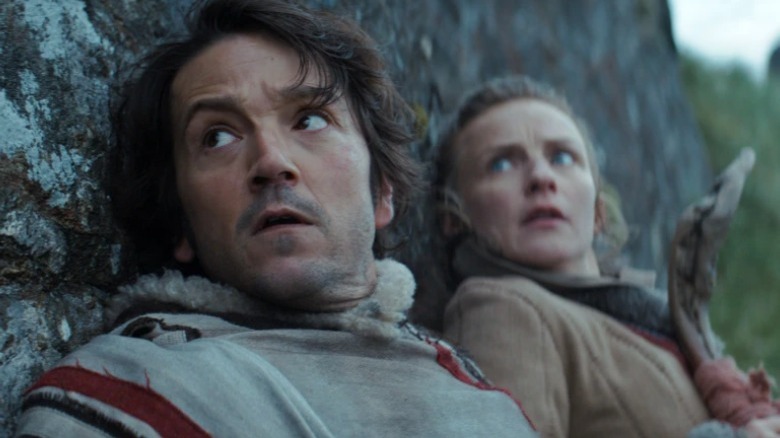Andor's Aldhani Looks The Way It Does Due To Last-Minute Covid Changes
Star Wars Celebration is off to an eventful start this week, with fans clamoring over the news of several new projects from Lucasfilm, including a film about the earliest days of the Jedi. With so many announcements ringing in our ears, it's easy to forget about some of the projects that are already in progress. A show we shouldn't eschew, however, is "Andor," which was one of the best TV shows of last year, and the /Film team was on the ground in London for the panel celebrating the show's first season and teasing the next.
The "Andor" panel included series creator Tony Gilroy and star Diego Luna, both of whom pulled double duty as executive producers on the show. Gilroy, Luna, and production designer Luke Hull shared several exciting stories about how the stylish, soulful, and surprisingly political show came to be, including some about filming in Scotland for scenes set on the mostly-deserted yet lush planet Aldhani. According to Gilroy, though, Aldhani wasn't actually meant to be quite as quiet as it turned out in the final product.
'We didn't want to do things just because they'd been done before'
"I can't do anything if I don't know where I really am," Tony Gilroy shared, admitting that scripts often change significantly once locations have been chosen. In this case, finding a part of Scotland that incorporated a hydroelectric dam — the Cruachan dam in Argyll, per the BBC — led to a unique opportunity for the show to portray Empire oppression. "We need to feel like it's 'Star Wars' but we didn't want to do things just because they'd been done before," Luke Hull explained. "We wanted something where the landscape was a big part of the story."
Hull says the team got interested in the idea of the dam as a new way of "showing imperial action on a planet that isn't just, you know, stormtroopers marching." Instead, it's an imposing, man-made structure intruding on natural resources. The storyline changed even more thanks to the timing of the shoot, which came squarely in the middle of the COVID-19 pandemic. "At one point there were supposed to be 3,000 people in that valley," Gilroy shared. "Well, we couldn't do that."
Landscape that makes a statement
Ultimately, pandemic safety constraints led to a pared-down vision of Aldhani, one in which the beautiful landscape is largely empty except for the Dead-enders, a group whose culture has been fading away in the wake of the fascist regime. Tony Gilroy describes some brief panic over finding alternatives to the large group scenes that couldn't take place because of COVID-19, but concluded:
"What comes out of that [is], 'Oh my God, you know what, it's actually about the Dead-enders. It's actually much more sad and much more potent and much more valuable to the story to have them be the Dead-enders and the last time they're ever gonna go there and the fact that they're just the remnants of something beautiful that has been destroyed."
COVID-19 protocols impacted the way the cast approached the shoot in Scotland as well. "We were in London when the confinement was like, we had to stay at home, and suddenly we were dropped in Scotland and allowed to interact and it was fabulous," Diego Luna told audiences at Star Wars Celebration, explaining that the shoot almost felt like an entirely different project since much of the cast from the Aldhani didn't appear in other episodes.
"Andor" is a memorable entry into the "Star Wars" canon for many reasons, but one is its ability to blend the visually striking with the morally repugnant. Just as the inmates in the show's later prison episode wear clean, white clothes inside a sleek, state-of-the-art building that hides death, the rolling green hills of Aldhani hide a culture that's dying. It's a production choice that fits in with the show's strange mix of bleakness and hope — and one that makes a much stronger impression thanks to its creative use of the natural landscape.


